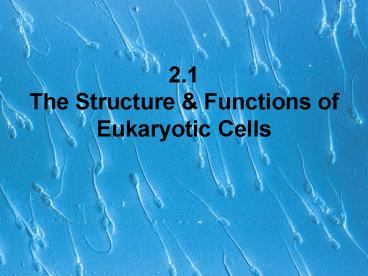2.1 The Structure - PowerPoint PPT Presentation
1 / 23
Title:
2.1 The Structure
Description:
Title: Cell Structure and Function Author: Jerry Cook Last modified by: WRDSB Created Date: 1/19/2005 1:28:04 AM Document presentation format: On-screen Show (4:3) – PowerPoint PPT presentation
Number of Views:70
Avg rating:3.0/5.0
Title: 2.1 The Structure
1
2.1The Structure Functions of Eukaryotic
Cells
2
Cells
- Smallest living unit
- Most are microscopic
3
Defining a Cell
- A cell is a confined system of potentially self
perpetuating linked organic reactions that are
catalyzed step-wise by enzymes.
4
Principles of The Cell Theory
- All living things are made of 1 or more cells
- Smallest living unit of structure and function of
all organisms is the cell - All cells arise from pre-existing cells
- (this principle discarded the idea of
- spontaneous generation)
5
Cell Size
6
Small Cells have a large Surface Area-to-Volume
Ratio. Why?
7
Why are S.A./Vol. Ratios Important?
- Surface area represents the access available to
and from a cell for supplies. - Volume represents how much has to be supplied.
- The more access you have to supply each unit of
volume, the more efficient the cell is.
8
Characteristics of Living Cells
- Very complex
- Very small
- Self-replicating
- Autonomous/semiautonomous
- Homeostatic
9
There are 2 Cell Types
- Prokaryotic
- Eukaryotic
10
Prokaryotic Cells
- First cell type on earth (chemosynthetic)
- All are single celled (ie Bacteria)
11
Prokaryotic Cells
- No membrane bound structures inside
- Nucleoid instead of nucleus (region of DNA
concentration). - Organelles not bound by membranes
12
Eukaryotic Cells
- Internal membrane bound organelles
- Cytoplasm (cytosol, organelles molecule ions
) for metabolism - Cell Membrane (Phospholipid bilayer)
- Can be Single or Multi-celled
Protozoan
13
(No Transcript)
14
Eukaryotic Animal Cell
15
Animal Cell Micrograph
16
Eukaryotic Plant Cell
17
Plant Cell Micrograph
18
Cytoplasm
- Viscous fluid containing organelles
- components of cytoplasm
- Interconnected protein filaments fibers
- Fluid cytosol
- Organelles (not nucleus)
- storage substances
19
Nucleus
- Control center of the cell
- Contains nucleoplasm
- Wrapped by a nuclear envelope which is a double
membrane. - Nuclear pore complexes form openings in nuclear
envelope - Contains
- Chromosomes (DNA)
- Nucleolus
20
Nucleus Micrograph
21
Chromosomes (DNA)
- Hereditary material
- Chromosomes
- - DNA proteins
- Short, thick strands
- form for cell division
- Chromatin
- - DNA proteins
- long, thin strands
- form for interphase
- DNA is transcribed translated into protein to
express hereditary traits
22
Nucleolus
- Non-membrane bound
- Contains RNA proteins
- Most cells have 2 or more.
- Directs synthesis of RNA
- Forms ribosomes
23
End of Part 1!































